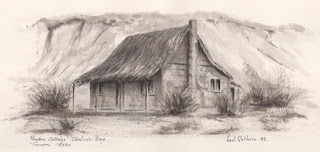The Fourth Holy Innocent.
Church of the Holy Innocents.
Mt Peel.
From a watercolour sketch
by Noel Guthrie 1994
Several years ago, and for the very first time, I took the opportunity to enter this small stone Church of the Holy Innocents, at Mt Peel, along the western corner of South Canterbury.
Even though I was alone, apart from a friendly fantail flitting between the high portals, the sense that I had company and a feeling of peace, was quite overpowering.
All around me, I saw history recorded in some shape or form. The extraordinary stained glass windows, as well as those polished memorial plaques adorning the wall.
In the small graveyard outside, etched in stone, were the names of those who have gone before. For some, only an unmarked rock, inscribed their passing.
Prior to the erection of this Church at Mt Peel, Mr J. A. B. Acland, a runholder and lay preacher at the time, conducted services several times a year in the Mt Peel homestead.
As I understand, an entry in Mr Acland's diary records a service conducted on the 10th December 1868, in which he wrote.
'Read the last of the Bishop of New Zealand's four sermons. At the time, I am sorry to say, Lang,(a neighbour) went to sleep, though he tried to disprove it by reading the middle part of the sermon, as the concluding sentences.'
I wonder how many of us have guilty of that little transgression from time to time.
At the base of Big Mt Peel and on the rise overlooking the deceptive Rangitata River, Emily Acland laid the foundation stone for this Church on the 14th December 1868.
Plans of the Church, previously drawn in true Gothic architecture by Mr Ashworth of Exeter, England, were a gift of the Rev. P. Acland, Vicar of Broardclyst and sub-Dean of Exeter Cathedral.
William Brassington of Christchurch won the contract to construct this church for a cost of four hundred and eighty-six pounds, eight shillings and sixpence, although the bell tower design was changed, to suit an alternative design submitted by Mrs Acland.
Quarried limestone used in the construction, was taken from a site at Mt Somers and carted across the Rangitata River by bullock dray. Other stone used in the project was collected from the Rangitata River flats.
Substantial Gothic portals, handcrafted of Totara timber, support an attractive handcrafted ceiling of New Zealand native Totara and Matai. Other hand-hewn furniture and fitting, also of native timbers, provide the simple necessities for up to eighty or more worshippers, to share in this tranquil setting.
In a letter written by Rev.L.L.Brown, after the consecration of this little Church on December 12th, 1869, he described the origin of its name. One passage of his letter brought forth a surge of emotion within me, where he wrote,
'The name, Church of the Holy Innocents, was chosen because there were three infant children, Emily Dyke Acland, Helen Irvine and Abner Clough, lay buried in the hillside.
On the day this church was consecrated, a solemn spot caught my eye. In a hedged enclosure, I saw a small wooden cross at the head of a little mound of earth, the soil recently disturbed.
This was the grave of the fourth holy innocent, Robert Irvine, who died in August 1869.
Services up until around 1921 were held only four or five times each year. Offerings collected, usually went to the Mission Funds, such as St Savours Orphanage or the Maori Girls School.
Yet it appears that this small Church lay quiet for some years, prior to 1947, when a notice in the 'Churchman', advised parishioners that services were to begin again.
At a centenary of the Church of the holy innocents, held on the 28th December 1969, it was Simon Acland, a great grandson of the pioneer and founder of this Church, who, in delivering his sermon he quoted.
'They had their share of suffering, disappointments and hardship, but they also had a vision and it rested with their faith in Jesus Christ.
They didn't plan, plant or build, just for themselves, they did it for the happiness and fulfilment of others.'
This small church at Mt Peel, to me at least, epitomises strength and a vision, of those settlers who braved almost intolerable elements, so that we, their descendants may live our lives in peace.



Comments
Post a Comment